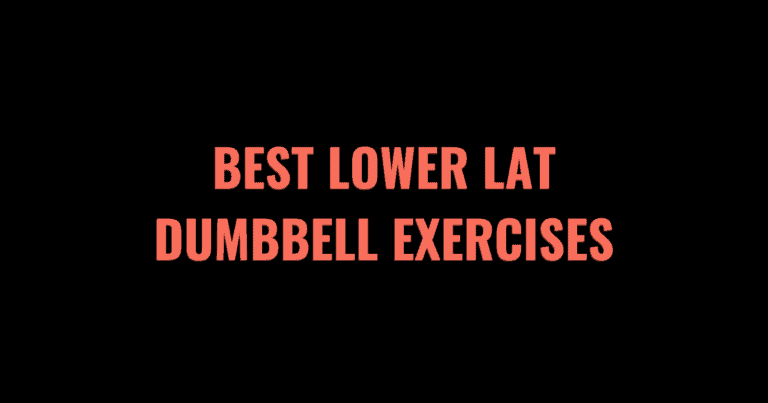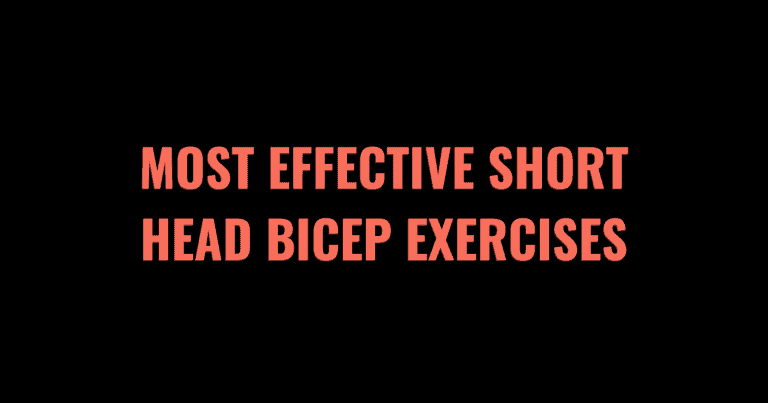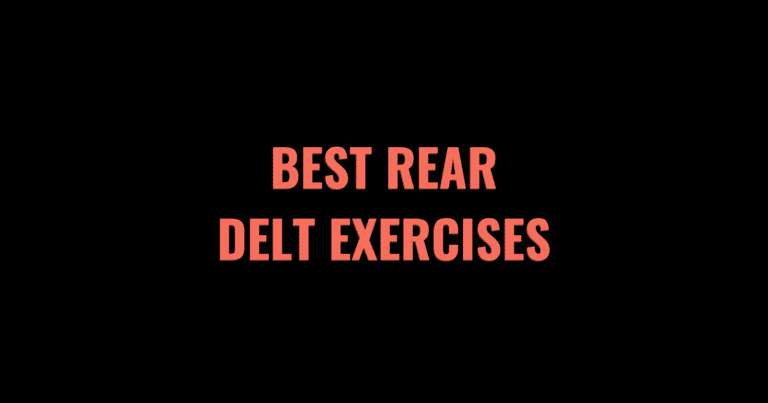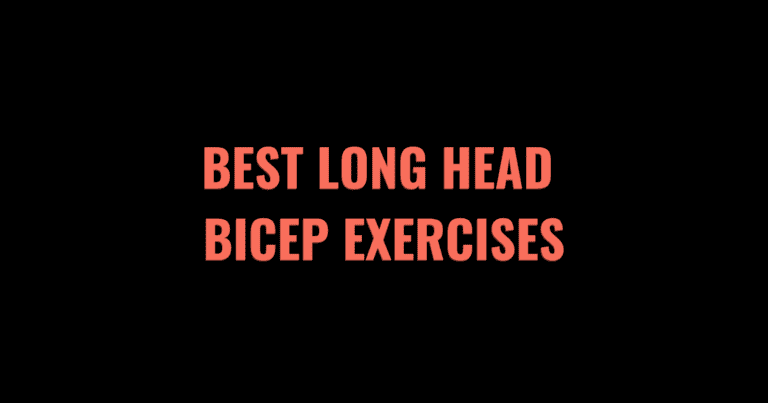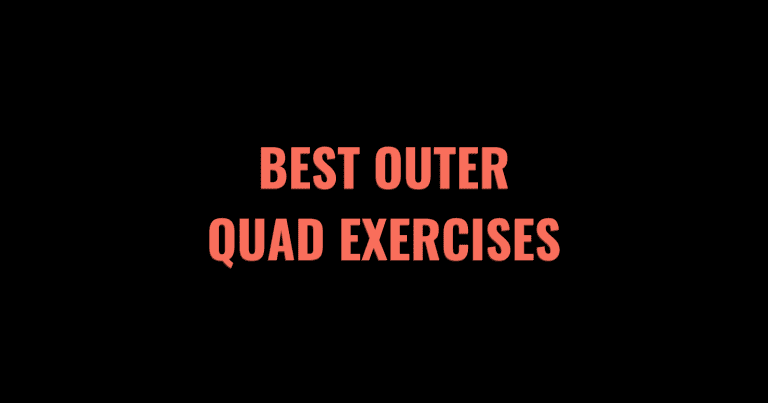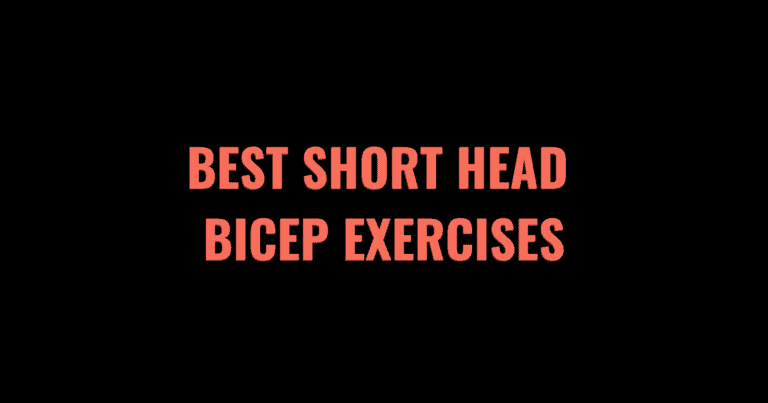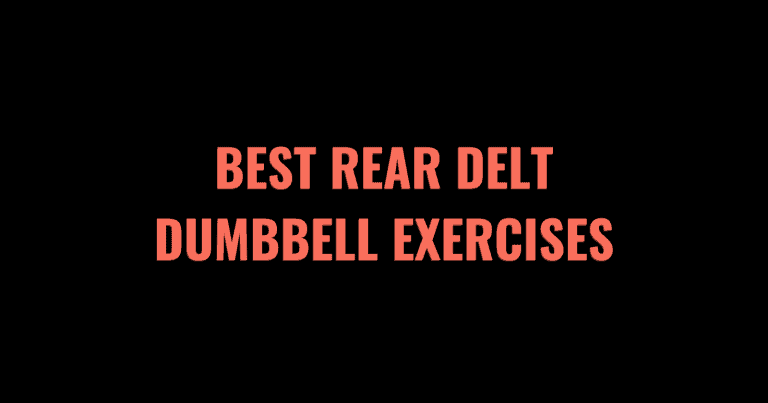Are you looking for the most effective way to build your bicep peak? If so, then you should primarily be focused on increasing the size, density, and strength of the long head of the biceps. The bicep is composed of two heads, the long head, and the short head. The long head is a bigger muscle and forms the bicep peak.
There are numerous bicep exercises, but specific ones target the long head of the biceps more than others. With that said, you cannot isolate the long head or the short head of the biceps, you can only emphasize one more than the other, and it’s all about your exercise selection.
In this article, we’re going to cover the top 8 exercises that target the long head of the bicep. If you start performing the movements listed below, you’ll soon develop an impressive, stage-worthy bicep peak.
Table of Contents
- 1 The Best Long Head Bicep Exercises
- 2 Long Head Emphasized Bicep Workout
- 3 Bicep Anatomy
- 4 Frequently Asked Questions
- 5 Final Thoughts
- 6 Other Muscle Groups Exercises
- 6.1 The 7 Best Lower Lat Dumbbell Exercises
- 6.2 The 10 Best Front Delt Exercises
- 6.3 The 8 Best Short Head Bicep Exercises
- 6.4 The 8 Best Rear Delt Bodyweight Exercises
- 6.5 The 7 Best Middle Trap Exercises
- 6.6 The 7 Best Medial Head Tricep Exercises
- 6.7 The 8 Best Rear Delt Exercises
- 6.8 The 6 Best Cable Rear Delt Exercises (2023)
- 6.9 The 6 Best Cable Hamstring Exercises
- 6.10 The 7 Best Long Head Bicep Dumbbell Exercises
- 6.11 The 7 Best Outer Quad Exercises (2023)
- 6.12 The 7 Best Lower Trap Exercises
- 6.13 The 9 Best Short Head Bicep Dumbbell Exercises
- 6.14 10 Best Cable Shoulder Exercises
- 6.15 The 9 Best Rear Delt Dumbbell Exercises [Tested]
- 7 References
The Best Long Head Bicep Exercises
- Close-Grip Barbell Curls
- Hammer Curls
- Incline Dumbbell Curls
- Bayesian Cable Curls
- Close-Grip Preacher Curls
- Dumbbell Curls
- Drag Curls
- Chin-Ups
Below you will find the most effective exercises for working the long head of the bicep:
Close-Grip Barbell Curls
Benefits of close-grip barbell curls
Close-grip barbell curls are one of the most effective mass-building exercises for the biceps, especially the long head. The more narrow grip allows you to better target the long head
Since this exercise is a bilateral movement, you should be able to lift more weight than a unilateral exercise such as dumbbell curls. Therefore, this exercise is better suited for progressive overload. All you need to perform this exercise is a barbell and some plates!
How to perform close-grip barbell curls
- Load a barbell with an appropriate amount of weight.
- Grab the barbell using a supinated grip (palms facing forward); your hands should be slightly inside of shoulder-width grip.
- Stand up straight, allow your arms to be fully extended with the barbell in front of your body, and keep your elbows by your sides throughout the entire movement. This is the starting position.
- Inhale, then begin to move the weight towards your body by flexing your elbows and contracting the biceps. Don’t let your upper arm sway forward excessively on the concentric portion of the lift.
- At the top of the rep, pause briefly and squeeze the biceps before exhaling and slowly lowering the barbell back to the starting position by extending your arms.
- Repeat for the desired number of repetitions.
Scott Herman demonstrates how to correctly perform close-grip barbell curls in the video below!
Hammer Curls
Benefits of hammer curls
One of the best ways to emphasize the long head of the biceps is by doing curls with a neutral grip, also known as hammer curls. Hammer curls are a great exercise for overall arm development because it activates muscles of the forearm and the biceps.
Some people prefer to do hammer curls instead of standard supinated curls because it places less strain on the wrists. Hammer curls are traditionally performed with dumbbells, which help prevent and/or correct any muscular or strength imbalances.
How to perform hammer curls
- Grab a pair of dumbbells and rotate them to where your palms are facing your body.
- Stand up straight and allow your arms to be fully extended with the dumbbells facing forward.
- Inhale, then begin to curl the dumbbell up towards your chest by flexing your elbows. Make sure your upper arm doesn’t swing too far forward during this portion of the lift.
- Once your arms are fully flexed, pause briefly and squeeze your biceps.
- Exhale as you lower the dumbbell back to the starting position by fully extending your arms.
- Repeat for the desired number of repetitions.
Watch the video below from Mind Pump Media to see how to perform dumbbell hammer curls!
Incline Dumbbell Curls
Benefits of incline dumbbell curls
Besides using a closer grip and neutral grip, another way to emphasize the long head of the biceps is to do a curl where your elbow is slightly behind your body. Since the long head crosses the shoulder and elbow joint, it also assists in shoulder flexion and elbow flexion and wrist supination.
Since your elbows are behind your body during a dumbbell incline curl, the exercise places the greatest stretch on the biceps, especially the long head. An exercise that uses a greater range of motion is likely to cause more growth, and that’s why incline dumbbell curls are quite popular for bicep hypertrophy.
Another benefit to doing incline dumbbell curls is that your torso is supported, and it’s much more difficult to cheat by using momentum. This engagement allows you to better isolate the biceps in general.
How to perform incline dumbbell curls
- To do this exercise, you will need an adjustable bench and dumbbells.
- Adjust the bench to a 45 to 60-degree angle. The steeper the incline, the easier the exercise is. If you’re a beginner, start with the 60-degree angle.
- Grab a pair of dumbbells and sit down on the bench. Lean back to where your back and head are fully supported by the bench. Your arms should be fully extended with the dumbbells facing forward at your sides.
- Inhale before curling the dumbbells up towards your body by flexing your elbows and contracting your biceps. The only thing that should be moving is your forearms. The upper arm should remain still throughout the movement.
- As you approach the top of the rep, slightly supinate your wrist even more by driving your pinky up. Once your arms are fully flexed, pause briefly and squeeze your biceps.
- Exhale and slowly lower the dumbbells back to the starting position by extending your arms.
- Repeat for the desired number of repetitions.
Jim Stoppani provides some tips on how to get the most out of the incline dumbbell curl in the video below!
Bayesian Cable Curls
Benefits of bayesian cable curls
Bayesian cable curls offer similar benefits to the incline dumbbell curl because your elbows are behind your body. However, one thing that incline dumbbell curls can’t provide you with is constant tension because it’s a free weight exercise. Performing cable exercises for biceps is ideal for the hypertrophic response.
Bayesian cable curls are usually performed with one arm at a time, so if you have a side that tends to be weaker, start with that side first and match the reps with the other arm. This exercise may not be as popular as some other bicep movements, but it’s definitely worth trying out, especially if you want to improve your bicep peak.
How to perform bayesian cable curls
- Attach a D-handle to a cable stack at the bottom position and select an appropriate amount of weight by moving the pin up or down.
- Facing away from the cable, grab the D-handle with your right hand using a supinated grip (palms facing forward).
- Take a few steps away from the cable stack and get into a split stance by placing your left leg forward and right leg back. Allow your upper arm and elbow to move behind your body while your arm is extended.
- Throughout the movement, keep your upper arm stable and your elbow behind your body.
- Inhale and begin to curl the D-handle up by flexing at the elbow and contracting the bicep. As you reach the top of the rep, supinate your wrists slightly more by driving your pinky up.
- At the top of the rep, pause for 1-2 seconds and squeeze the biceps before exhaling and lowering the d-handle back to the starting position by extending your arms.
- Repeat for the desired number of repetitions and match the number of reps with the left arm.
Watch the video below for a video demonstration of the bayesian cable curl from GymSpot!
Close-Grip Preacher Curls
Benefits of close-grip preacher curls
Preacher curls may not place your elbow behind your body, but they are still a great way to target your biceps. The main benefit of doing preacher curls is that your upper arm is supported against a pad, so cheating is extremely difficult.
Although you can use a variety of equipment to do preacher curls, we recommend using a close-grip with an EZ-bar to emphasize the long head of the biceps. The cambered bar is often more comfortable on your wrist and accessible at nearly every gym.
How to perform close-grip preacher curls
- To do this exercise, you will need a barbell or EZ-Bar, plates, and preacher curl bench.
- Adjust the height on the seat of the preacher curl to where your upper arm rests comfortably against the pad. Place the EZ-Bar or barbell on the rack.
- Stand up and grab the barbell with a supinated grip that’s just inside shoulder-width.
- Curl the weight up, place your upper arms against the support pad, and sit down on the bench. This is the starting position.
- Inhale while you begin to lower the barbell towards the rack by extending your arms. At the bottom of the movement, don’t allow your elbows to lock out because that may place you at a higher risk for bicep injury. Keep a slight bend in your arms.
- At the bottom of the rep, you should feel a stretch in the biceps. Pause for 1-2 seconds, then exhale and drive the barbell or EZ-Bar up towards your upper body by flexing your elbows and contracting the biceps.
- Pause again for 1-2 seconds at the top, then repeat for the desired number of repetitions.
Check out the video below to see how to correctly perform a close-grip EZ-bar preacher curl:
Dumbbell Curls
Benefits of dumbbell curls
Arguably the most common bicep exercise, the traditional dumbbell curl is a staple for many fitness enthusiasts looking to grow their biceps. The dumbbell curl is easy to learn, requires minimal equipment, and you can perform the movement nearly anywhere.
Dumbbell curls are considered to be a unilateral exercise, which is a unique benefit that barbells don’t offer. Unilateral exercises are optimal for hypertrophy because they help enhance symmetry in addition to adding size and strength.
How to perform dumbbell curls
- Grab a pair of dumbbells with a supinated grip (palms facing forward). Stand up straight with a shoulder-width stance. With your arms fully extended, move the dumbbells to the sides of your body.
- Inhale, then begin to curl the dumbbells up towards your body by flexing your elbows and contracting your biceps. As you approach the top of the rep, supinate your wrists slightly more by driving your pinky up.
- At the top of the rep, squeeze your biceps and pause for 1-2 seconds.
- Exhale while you lower the dumbbells back to the starting position by extending your arms.
- Repeat for the desired number of repetitions.
Mind Pump Media showcases the most effective way to perform dumbbell bicep curls in the video below!
Drag Curls
Benefits of drag curls
Drag curls are a more advanced variation of a traditional bicep curl. They are traditionally performed with a barbell or smith machine. Drag curls target the long head slightly more because you draw your elbows backward while curling the weight up.
One unique feature about this bicep exercise compared to other curls is that the barbell moves in a straight path up rather than curving towards and away from the body. They are often done with a smith machine because most are designed to move straight up and down.
Drag curls may be more difficult to learn proper technique, but once you do, it will become a staple exercise in your workout routine.
How to perform drag curls
- You can either do this exercise using a barbell or a smith machine.
- Grab a barbell with a supinated grip (palms facing up); your hands should be shoulder-width apart.
- Stand up straight with a shoulder-width stance. The barbell should be in front of you and your arms fully extended.
- Inhale and begin to curl the barbell upwards by flexing your elbows, contracting the biceps, and simultaneously drawing your elbows backward. The barbell should stay close to your body and move in a relatively straight path up and down.
- Once your arms are fully flexed, pause briefly and squeeze your biceps.
- Exhale while lowering the barbell back to the starting position by extending your arms and moving your elbows forward.
- Repeat for the desired number of repetitions.
John “Mountain Dog” Meadows explains how to do drag curls in the video below!
Chin-Ups
Benefits of chin-ups
Most people think that chin-ups are a back exercise, but when you do them in a specific way, they are very effective for targeting the biceps. To place more emphasis on the biceps, focus on getting your chin up to the bar and flexing your elbows rather than engaging the back through retracting the shoulders. You should also try to stay fairly upright rather than leaning back.
Chin-ups are one of the few bodyweight and compound exercises that engage the biceps. They are a better mass builder for the biceps. Although chin-ups only require your body weight, you can add weight to make them more difficult or use a band for some assistance.
How to perform chin-ups
- Grab onto a chin-up bar with a supinated grip (palms facing you). Your hands should be slightly closer than shoulder-width apart.
- With your arms fully extended, let your legs hang down or bend your knees and cross them behind your body.
- Inhale, then begin to pull your chin up to the bar primarily through elbow flexion.
- Once your chin is over the bar, pause for 1-2 seconds and squeeze your biceps.
- Exhale while you slowly lower your body back to the starting position by extending your arms.
- Repeat for the desired number of repetitions.
Watch the video below from Mind Pump Media to see how to perform chin-ups in a way that targets your biceps more than your back!
Long Head Emphasized Bicep Workout
Now that we’ve covered the top 8 exercises for building your bicep peak, let’s place them into a workout program that you can follow along with!
Below you will find a long head emphasized bicep workout that uses this spreadsheet and Renaissance Periodization’s Bicep Growth Training Tips as a guide.
- Week 1 – 10 sets
- Day 1 – Incline Dumbbell Curls: 2 sets x 12 reps @ 60%, Close-Grip Barbell Curls: 2 sets x 10 reps @ 70%
- Day 3 – Chin-Ups (weighted, assisted, or bodyweight): 2 sets x 8 reps @ 75%
- Day 5 – Bayesian Cable Curls: 2 sets x 12 reps @ 60%, Hammer Curls: 2 sets x 10 reps @ 70%
- Week 2 – 12 sets
- Day 1 – Incline Dumbbell Curls: 3 sets x 12 reps @ 60%, Close-Grip Barbell Curls: 2 sets x 10 reps @ 70%
- Day 3 – Chin-Ups (weighted, assisted, or bodyweight): 3 sets x 8 reps @ 75%
- Day 5 – Bayesian Cable Curls: 2 sets x 12 reps @ 60%, Hammer Curls: 2 sets x 10 reps @ 70%
- Week 3 – 14 sets
- Day 1 – Incline Dumbbell Curls: 3 sets x 12 reps @ 60%, Close-Grip Barbell Curls: 3 sets x 10 reps @ 70%
- Day 3 – Chin-Ups (weighted, assisted, or bodyweight): 3 sets x 8 reps @ 75%
- Day 5 – Bayesian Cable Curls: 3 sets x 12 reps @ 60%, Hammer Curls: 2 sets x 10 reps @ 70%
- Week 4 – 16 sets
- Day 1 – Incline Dumbbell Curls: 3 sets x 12 reps @ 60%, Close-Grip Barbell Curls: 3 sets x 10 reps @ 70%
- Day 3 – Chin-Ups (weighted, assisted, or bodyweight): 4 sets x 8 reps @ 75%
- Day 5 – Bayesian Cable Curls: 3 sets x 12 reps @ 60%, Hammer Curls: 3 sets x 10 reps @ 70%
- Week 5 – 6 sets (Deload)
- Day 1 – Incline Dumbbell Curls: 1 sets x 12 reps @ 60%, Close-Grip Barbell Curls: 1 sets x 10 reps @ 70%
- Day 3 – Chin-Ups (weighted, assisted, or bodyweight): 2 sets x 8 reps @ 75%
- Day 5 – Bayesian Cable Curls: 1 sets x 12 reps @ 60%, Hammer Curls: 1 sets x 10 reps @ 70%
Bicep Anatomy
The biceps are located on the front of your upper arm. They originate at the shoulder and attach to the forearm. Since the bicep crosses two joints — the shoulder & elbow — it’s referred to as a biarticular muscle. As the name implies, the biceps comprises of two heads, one is called the long head, and the other is called the short head.
The long head sits on the outside of the arm, whereas the short head is located on the inner side. If you’ve ever seen someone flex their biceps and have an impressive peak, it means that their long head is well developed. On the other hand, if someone’s bicep has more width and thickness than height, that means their short head is better developed.
The primary action of the bicep is to flex the elbow, but it also contributes to wrist supination and shoulder flexion. Although you can’t isolate one bicep head, manipulating your grip and elbow placement can help target a specific area of the best.
For a visual reference on the anatomy of the bicep, watch this video!
Frequently Asked Questions
Any exercise that involves one head of the bicep will also engage the other. The primary way to target the biceps is through elbow flexion, and both heads work simultaneously to produce that action. Long story short, you cannot isolate one head of the biceps.
Here are some tips for emphasizing the long head of the biceps:
1. Keep your elbows by your sides or behind you while doing elbow flexion.
2. Use a neutral or supinated grip (palms facing your body or forward).
3. Keep your hands slightly closer than shoulder width.
The exercises covered in this article best emphasize the long head. Make sure a few of them are in your routine if you’re trying to increase the size of your bicep peak!
The answer to this question will depend on your training split and how much training volume you’re performing for your biceps. The more training volume you’re doing, the better it is to increase the frequency that you train the biceps. Rather than doing 10 sets in a single session, it’s more optimal to do 5 sets split up into two sessions.
For most people, the ideal frequency for bicep training is somewhere between 2 and 6 times per week. Keep in mind that several back exercises also target the biceps, so training the biceps along with the back is a popular approach.
The biceps will benefit the most from training in the 30% to 80% intensity based on your 1-rep maximum. Roughly 50% of your bicep training should be performed in the 50-70% intensity range. The other half can be performed above 70% intensity and/or below 50% intensity.
At least half of your bicep training should be performed in a moderate rep range (10-20 reps). The other half can be split evenly between a heavy rep range (5-10 reps) and a light rep range (20-30 reps). Doing a variety of rep ranges is optimal for overall bicep hypertrophy since you’re targeting both fast and slow muscle fibers.
Furthermore, some exercises are better suited for heavy, moderate, or light rep ranges. For example, weighted chin-ups are perfect for the 5-10 rep range. In contrast, cable curls are better for the 10-20 or even 20-30 rep range.
Final Thoughts
Every time you step into the gym, you’ll see someone doing a bicep curl. And anytime you tell someone to show you their muscles, a bicep flex is more than likely what they will do. The biceps is known as a “show muscle,” and nothing says “I lift” quite like big arms.
Although performing rows, pulldowns, and pull-ups engage the biceps, they aren’t enough to build an impressive set of arms. That’s why incorporating bicep isolation exercises into your workout routine is a good idea. How big of a peak your biceps have and how thick they are is largely dependent on your genetics and muscle insertions.
Doing the exercises listed in this article will help you get closer to having bicep peaks the size of Arnold’s. We’ve equipped you with the knowledge; now all you have to put in the work and enjoy the gains!
Other Muscle Groups Exercises
If you enjoyed this post, check out our other collections of the best exercises for each muscle group below.
References
1. Israetel, Mike. Oct. 2020. “Bicep Growth Training Tips.” Renaissance Periodization. https://rpstrength.com/expert-advice/bicep-training-tips-hypertrophy
